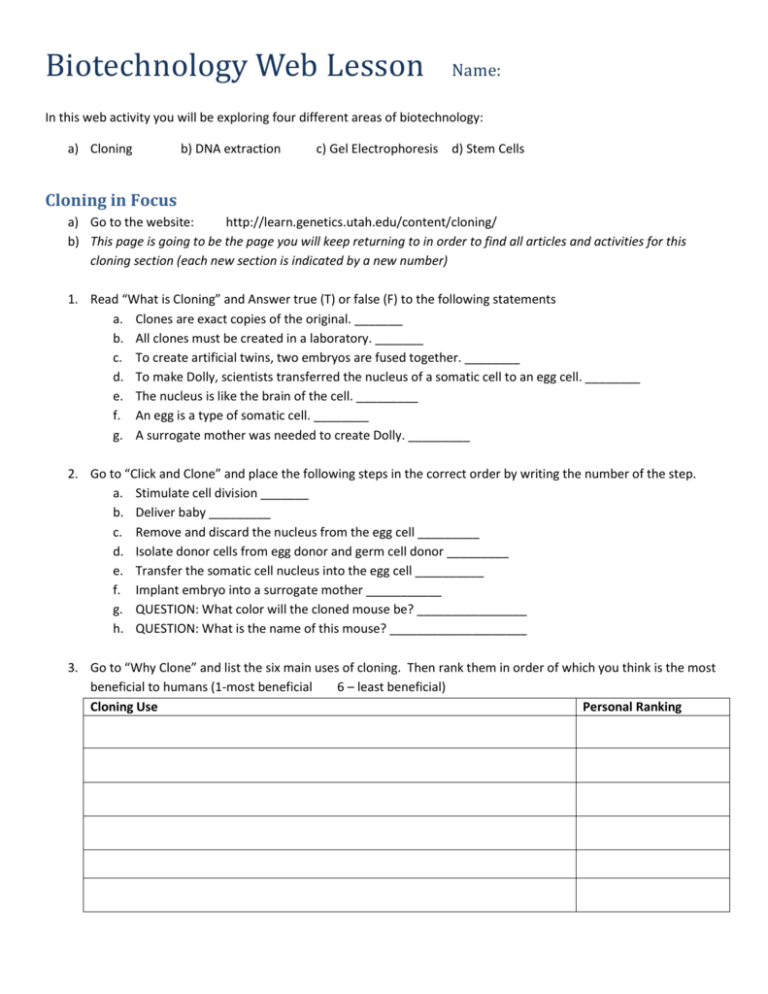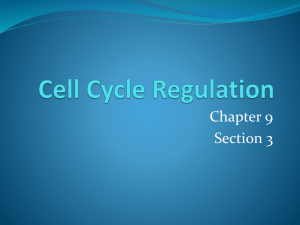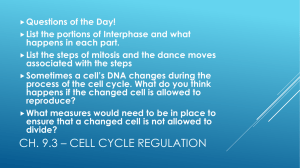Biotech Webquest
advertisement

Biotechnology Web Lesson Name: In this web activity you will be exploring four different areas of biotechnology: a) Cloning b) DNA extraction c) Gel Electrophoresis d) Stem Cells Cloning in Focus a) Go to the website: http://learn.genetics.utah.edu/content/cloning/ b) This page is going to be the page you will keep returning to in order to find all articles and activities for this cloning section (each new section is indicated by a new number) 1. Read “What is Cloning” and Answer true (T) or false (F) to the following statements a. Clones are exact copies of the original. _______ b. All clones must be created in a laboratory. _______ c. To create artificial twins, two embryos are fused together. ________ d. To make Dolly, scientists transferred the nucleus of a somatic cell to an egg cell. ________ e. The nucleus is like the brain of the cell. _________ f. An egg is a type of somatic cell. ________ g. A surrogate mother was needed to create Dolly. _________ 2. Go to “Click and Clone” and place the following steps in the correct order by writing the number of the step. a. Stimulate cell division _______ b. Deliver baby _________ c. Remove and discard the nucleus from the egg cell _________ d. Isolate donor cells from egg donor and germ cell donor _________ e. Transfer the somatic cell nucleus into the egg cell __________ f. Implant embryo into a surrogate mother ___________ g. QUESTION: What color will the cloned mouse be? ________________ h. QUESTION: What is the name of this mouse? ____________________ 3. Go to “Why Clone” and list the six main uses of cloning. Then rank them in order of which you think is the most beneficial to humans (1-most beneficial 6 – least beneficial) Cloning Use Personal Ranking 4. Go to “Why Clone” and read about CC and Rainbow under reproducing a deceased pet. Explain in your own words why the cloned cat did not look like the original. Use complete sentences. ___________________________________________________________________________________________ ___________________________________________________________________________________________ ___________________________________________________________________________________________ 5. Go to “Is it Cloning or Not” and for each of the following, indicate Y (Yes) or N (NO). a. [Y or N] Sperm taken from a male goat is combined with a female’s egg in a petri dish. The resulting embryo is implanted into the female’s uterus to develop. b. [Y or N] A sheep embryo, composed of 16 cells, is removed from the mother’s uterus and separated into individual cells. Each cell is allowed to multiply, creating 16 separate embryos, which are then implanted in different female sheep to develop to maturity. c. [Y or N] A cow with many desirable traits is stimulated with hormones to produce a number of egg cells. Each of these eggs is fertilized and implanted into a surrogate mother. d. [Y or N] In vitro fertilization e. [Y or N] Cell nuclei from an extinct woolly mammoth are place into enucleated cow cells. DNA Extraction a) Go back to the website: http://learn.genetics.utah.edu/content/labs/ b) At the bottom of the website under the heading “Virtual Labs” click on “DNA Extraction” c) Follow through the interactive feature and answer the questions below. 1. List three reasons for extracting DNA from a human subject. ________________________________________ __________________________________________________________________________________________ 2. Describe in detail where DNA is found in the cell: __________________________________________________ __________________________________________________________________________________________ 3. In our virtual test subject, where did we get cells from? _____________________________________________ 4. List the four steps needed to extract DNA: a. ____________________________________________________________________________ b. ____________________________________________________________________________ c. ____________________________________________________________________________ d. ____________________________________________________________________________ 5. The lysis solution contains detergent, the detergent will do what to the cell? ___________________________________________________________________________________________ 6. What does the salt do to the cellular mixture? ___________________________________________________________________________________________ 7. The centrifuge spins really fast and causes the debris to do what? ___________________________________________________________________________________________ 8. Isopropyl alcohol causes DNA to do what? ___________________________________________________________________________________________ Gel Electrophoresis a) Go back to the website: http://learn.genetics.utah.edu/content/labs/ b) At the bottom of the website under the heading “Virtual Labs” click on “Gel Electrophoresis” c) Follow through the interactive feature and answer the questions below. 1. 2. 3. 4. 5. Electrophoresis is used to sort DNA by __________________________. What is placed into the holes at the end of the gel? _____________________ By adding electric current, we can make the DNA do what? _____________________ Shorter strands of DNA move (farther or slower) than longer strands? Place the following steps in the correct order a. __________ Load DNA sample into the gel b. __________ Stain the gel and analyze the results c. __________ Make the gel d. __________ Hook up the electrical current e. __________ Set up gel apparatus 6. In the “Gel Electrophoresis Laboratory” follow the steps to make your own gel, answer the questions as you go a. What is agarose made from? _____________________________ b. Melted agarose is poured into a ___________________________ c. Buffer __________________________ electric current in the electrophoresis box. d. In real life, loading samples into the gel wells takes __________________________. e. The black end generates a _______________ charge, the red end a ________________ charge. f. The bubbles in the electrophoresis box are _____________________ that your current is running. g. Staining the DNA will make it show up under a___________________________ light. h. What are your estimates for the number of base pairs in the three bands? ________, _________, ______ 7. Not from the website but Gel Electrophoresis is used to match up sets of DNA data. Whoever has the closest match is your suspect. So who committed the crime? ___________ Explain your answer. _____________________________ _________________________________________________________________ _________________________________________________________________ _________________________________________________________________ Stem Cells a) Go back to the website: http://learn.genetics.utah.edu/content/stemcells/ b) Click on “Stem Cells” use the stem cells quick reference link if you need to look up any definitions. 1. Click on “Nature of Stem Cells” View the slide show of stem cells and answer the following questions. a) Specialized cells that have a specific function. They are (differentiated or undifferentiated) cells? b) Stem cells do not yet have a specific function. They are (differentiated or undifferentiated)cells? Stem cells can give rise to many different types of cells including other __________ cells. c) Stem cells play an important role from __________________ development through adulthood. d) Development begins when ____________ and ___________ meet. This produces a special type of stem cell that has the potential to grow into a new human being. e) For the first few divisions the cells remain _____________________________. f) As development continues a signal will be released and this will gradually limit a cells potential. ______________________ has begun. g) One week after fertilization the embryo is called a __________________________ looks like a lopside hollow ball. Cells around the outside will form the ______________________. The clump of cells on the inside will form ____________________________________. h) After _______________ weeks of fertilization the cells of the embryo organize into __________ layers. Each layer will give way to a different set of cell types. i) What does the following layers become: Outer layer __________________________________________________________________ Middle layer _________________________________________________________________ Inner layer ___________________________________________________________________ j) There are approximately how many types of cells in a developed body? _____________ Even after adulthood pockets of stem cells remain that are called _________________ cells (adult cells). What is the role of these cells? ___________________________________________________ k) Some cells sit quietly waiting for a signal while others are constantly replacing cells that are lost through __________________________. The example in the slideshow is showing skin cells. l) Somatic stem cells differ from embryonic stem cells in that under natural conditions they give rise to just a _____________ cell types. Example: what type of stem cell can be used to create blood cells?______________________________ m) What are all of the other tissues that somatic stem cells have been found in? _________________________________________________________________________________________ 2. Go to “Unlocking Stem Cell Potential” a. What are two examples of items (with what they regenerate) that use stem cells for regeneration of body parts? __________________________________________________________________________________________ __________________________________________________________________________________________ b. Regeneration in humans is __________________. For the most part we can use stem cells to heal injuries. It cannot be used to replace _________________________. c. What is the goal of regenerative medicine? ___________________________________________________ _______________________________________________________________________________________ d. Why do scientists want to coax the pockets of stem cells in the tissues of our body to go beyond their natural healing abilities? __________________________________________________________________ ______________________________________________________________________________________ e. What types of drugs might already be stimulating stem cell activity, and how? _______________________ _______________________________________________________________________________________ _______________________________________________________________________________________ f. Another approach is to _________________ stem cells in a lab and transplant them into patients. g. Besides bone marrow stem cells they are also looking at embryonic and pluripotent stem cells. Why are they interested in these two types of stem cells? _______________________________________________ _______________________________________________________________________________________ h. Embryonic and pluripotent stems cells can live indefinitely in a culture, where they can be grown by the millions. By giving these cells certain signals what types of cells can these turn into that could eventually be transplanted into a patient? _________________________________________________________________ ________________________________________________________________________________________ i. They are engineering patches of skins to repair tissues. But what are they creating for animals? ________________________________________________________________________________________ j. Stem cell transplants who promise for treating what types of injuries? _____________________________ k. Through the use of gene targeting technology scientists were able to cure what blood disorder in mice? ______________________________ Maybe they will be able to use this with humans. l. How are stem cells related to cancer? ________________________________________________________ _______________________________________________________________________________________ _______________________________________________________________________________________ 3. Go to “Go, Go, Stem Cells” and complete the following questions a. What is a “stem cell niche” __________________________________________________________ b. What are the 5 stem cell niches in the body? _______________________________________________________________________________________ 4. Go to “The stem cell debate is it over” read the article relating to hES cells and IPS cells. i. What does hES stand for? __________________________________________ ii. What does iPS stand for? ___________________________________________ iii. Where do iPS cells come from Adult or embryonic cells? __________________ iv. Why is there such excitement / controversy over iPS cells (may also need to scroll down to iPS cells problem solved to help answer) ? _________________________________________ _____________________________________________________________________________ ______________________________________________________________________________ ______________________________________________________________________________ b. Find out what are the 5 ethical questions to ponder regarding stem cells? Then answer Yes or No to each of them if it is a yes/no question. 1. __________________________________________________________________________________ __________________________________________________________________________________ 2. __________________________________________________________________________________ __________________________________________________________________________________ 3. __________________________________________________________________________________ __________________________________________________________________________________ 4. __________________________________________________________________________________ __________________________________________________________________________________ 5. __________________________________________________________________________________ __________________________________________________________________________________ 4. What do you think? Ethical questions. A. Many unused embryos produced through in vitro fertilization will be discarded. Should researchers be able to use these embryos for stem cell research? Yes or No B. Should government make laws to regulate stem cell research? Yes or No C. Should therapeutic cloning be permitted with regulation? Yes or No D. Would your views be different if you or a close family member had a medical condition that could be cured through stem cell cloning? Yes or No 5. Read through the bottom of the page Stem Cell Research Legislation. How has government played a part in stem cell research? Be thorough with your answer: ______________________________________________________________ _________________________________________________________________________________________________ _________________________________________________________________________________________________ _________________________________________________________________________________________________ _________________________________________________________________________________________________ _________________________________________________________________________________________________ _________________________________________________________________________________________________









